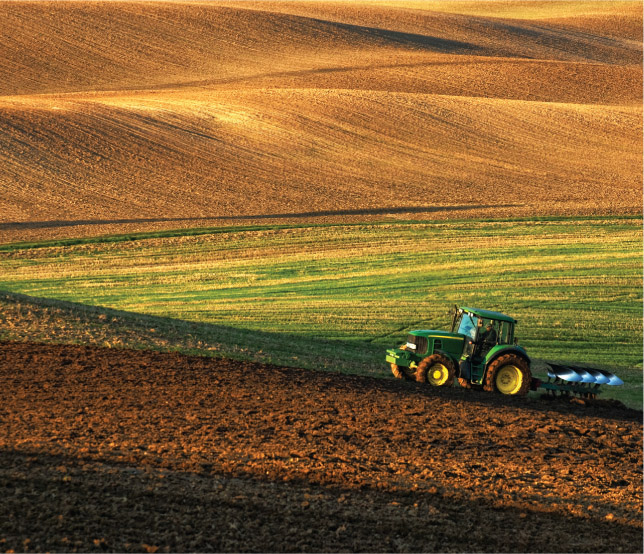17.1 Participants in the Australian economy
There are a number of participants in the Australian economy. All of these participants – workers (employees), businesses, consumers and the government – have a role to play in the economy and can influence the way the economy operates.
Employees
Employees or workers are an important part of the business and are an input that supports the production of goods and provides services. Employees usually have to have skills and experience to produce a high-quality product. In Australia we have a highly skilled workforce in most industries and sectors of the economy. While in the past the Australian economy was based on primary industry (agriculture, wool, beef and natural resources) and then manufacturing (production of goods from inputs), it is now increasingly based on the tertiary sector, meaning that employees are more involved in providing services than products.

| Sector or industry | Examples |
|---|---|
| Primary sector Extracts or harvests products or raw materials from the natural environment. |
Agricultural industries such as farming and grazing, mining, fishing and hunting. Primary products are known as commodities. Those produced in Australia include wheat, wool, fish, timber and iron ore. The packaging and processing of raw materials are also considered to be part of the primary sector. |
| Secondary/manufacturing Creates finished goods (tangible products) through combining factors of production in a production process. |
Construction, engineering, car manufacturing and factories. |
| Tertiary/service Provides intangible products known as services. Workers in this sector sell their labour and expertise; 85% of Australians work in service industries. The quaternary sector is the branch of the tertiary sector that provides intellectual activities. The quinary sector contains businesses that are in hospitality and services such as household services. |
Retail, professional services, media, tourism and banking. Parts of this sector include government, education, scientific research and IT. Examples of quinary businesses include restaurants, Jim’s Mowing and cleaning. |
-

-

Source 17.2 While in the past the Australian economy was based on primary industry (left) and manufacturing, it is now increasingly based on the tertiary sector (right).
DEVELOPING YOUR UNDERSTANDING 17.1
- Read the following scenario and identify four goods and four services purchased by Eric.
Eric was extremely unhappy when his car failed to start as it meant he would have to take public transport to his university lecture. While sitting on the train he thought about the Saturday night football game he had bought tickets for, and ate a chocolate bar. Once Eric got home he planned to take his car to the mechanic for repairs, but before that he planned to go to Westfield shopping centre to purchase a new pair of jeans.
- Classify each of the following businesses according to the industry sector they are part of:
- a electrical retailer
- a plumber
- a sheep grazier
- a professional sportsperson
- a radio station
- an accounting firm
- a childcare centre
- a professional fishing boat
- a department store.
Australia is in a phase where there are many challenges in terms of the future of the economy. The secondary sector of the economy is changing and some manufacturing businesses, such as the car manufacturing industry, will stop operating during the next few years. There has been a move towards a ‘knowledge economy’, meaning workers will need to develop skills in areas and industries not yet developed if the economy is to remain competitive.
DEVELOPING YOUR UNDERSTANDING 17.2
Read the extract and answer the questions below.
Robots will not take over manufacturing jobs but will enhance future employment opportunities, according to a report on production in Australia. As demand for workers with a higher level of skills increases, some workers will find themselves at risk of losing their jobs. Traditional jobs will change and people will start to complete jobs with fewer repetitive tasks and more ‘high value’ tasks instead. New technologies in mechanical and electrical manufacturing will mean that workers will need to operate and manage computerised machinery and equipment.
This means that some workers who do not have the necessary skills may find themselves unemployed.
The report also warned that Australia was behind other countries in linking education and employment. It also stated that there needs to be deeper connections between manufacturing and universities to supply skilled graduates with the expertise to ensure that industry is able to remain viable.
Source 17.3 Extract based on the article ‘Robots won’t end manufacturing jobs but will change them, says productivity report’
- Suggest why the use of robotics in manufacturing industry has changed people’s work.
- The report has found that Australia will need to have more skilled workers. Explain why businesses, TAFEs and universities need to work together on this.
RESEARCH 17.1
Visit a job-finding website such as SEEK (www.cambridge.edu.au/hass9weblinks) and research two jobs in the manufacturing sector.
- List the job titles.
- Outline the skills and qualities required.
- Create your own job advertisement for an opportunity in the manufacturing sector. List all the job prerequisites and desired qualities.
- Calculate a suitable salary for your job description.
Consumers
Consumers or customers are important in the economy. In traditional economic theory it was argued that the producers always decided what consumers could purchase. In our modern economy consumers have more power over what they will buy.
Consumers use their disposable income and salary to purchase goods and services. Some of these are needs (necessities such as food, clothing and shelter) and others are wants (items or services a person would like but does not require, such as a holiday or going out for dinner).
Consumers make decisions about what they will or will not purchase every day. They have some influence over what producers will produce and the types of products they provide for the market they operate in.

The top 10 favourite global brands for 2013 were:
- Apple
- Coca-Cola
- GE
- IBM
- Intel
- McDonald’s
- Microsoft
- Samsung
- Toyota.
There are a number of laws and regulations that protect the rights of consumers in Australia – these laws may differ between each state. Producers will usually try to respond to the demands and change in tastes in their customers to ensure that they are able to continue to sell their products.
RESEARCH 17.2
Use the internet to research the consumer affairs body in your state or territory and complete the following tasks:
- Describe three laws or regulations that cover consumers.
- Explain what someone should do if a company has breached a law or regulation.
- Think about a good you have bought over the past month – it could be anything from food to a new phone, clothing or a pair of shoes. Answer the following questions:
- Why did you buy the product?
- Were you influenced by other people, the price or advertising?
- Discuss your answers with other students in the class.
- How many were influenced by advertising?
- What conclusions can be drawn from the class’s comments?
Producers
A producer is a person or, in most cases, a business that makes a product or good, or provides a service to consumers. An economy such as Australia is based on the production of goods and services.

| Production | Period | Units | Value | Change from previous period | Change from corresponding period last year |
|---|---|---|---|---|---|
| Income from sales of goods and services by manufacturers in volume terms - trend | Dec 2013 | $m | 89 531 | 0.2% | −0.9% |
| Dwelling unit approvals - trend | Feb2014 | No. | 17 073 | 0.7% | 27.6% |
| Building approvals - trend | Feb2014 | $m | 8303.8 | 0.2% | 18.5% |
| Total dwelling units commenced -trend | Jun Qtr 2012 | No. | 33 125 | −2.1% | −14.0% |
| Building work done - chain volume measures -trend | Dec Qtr 2013 | $m | 20 958.5 | 0.2% | 2.7% |
| Engineering construction work done -chain volume measures - trend | Dec Qtr 2013 | $m | 32 448.2 | 1.3% | 1.1% |

Key points
- The trend estimate rose 0.7% in February 2014. This follows a rise of 0.7% in January 2014 and a rise of 0.7% in December 2013.
- The seasonally adjusted estimate rose 0.2% in February 2014. This follows a rise of 1.2% in January 2014 and a rise of 0.7% in December 2013.
- In trend terms, Australian turnover rose 5.9% in February 2014 compared with February 2013.
- The following industries rose in trend terms in February 2014: food retailing (0.7%); household goods retailing (1.0%); cafes, restaurants and takeaway food services (1.2%), other retailing (0.5%); and clothing, footwear and personal accessory retailing (0.1%). Department stores (–0.4%) fell in trend terms in February 2014.
- The following states and territories rose in trend terms in February 2014: New South Wales (1.0%), Victoria (0.7%), Queensland (0.5%), Western Australia (0.2%), Tasmania (0.9%), South Australia (0.3%) and the Northern Territory (0.4%). The Australian Capital Territory (–0.1%) fell in trend terms in February 2014.
DEVELOPING YOUR UNDERSTANDING 17.3
The top Australian start-up company in 2014 was Zookal & Flirtey. The textbook rental company Zookal has teamed up with Flirtey to deliver parcels in Australia using fully automated drones.
Goods and services are created (produced) for consumption by consumers through combining economic resources known as the factors of production, which include:
- land and raw materials
- utilities such as gas, water, electricity and water
- labour (workers)
- capital resources such as buildings, vehicles and machinery
- entrepreneurial resources – ideas, vision and drive to come up with ideas.

Governments
Governments make economic decisions around three key questions:
- What will be produced with the economic resources available? (Types of products and in what quantities)
- How to produce? (Methods of production to be used)
- Who will receive the finished products? (Distribution)
The economic system and the economic decisions taken by government will vary according to the economic beliefs or philosophy held by those in government. Governments that are socialist, for instance, tend to believe in greater degrees of government control and influence in the economy. They will therefore make decisions regarding the utilisation of the economic resources of the nation.
In contrast, governments that are advocates of free market economics are more inclined to let the market determine key economic decisions regarding what to produce, how to produce and the distribution of production. This is done by allowing the price mechanism to operate.
One of the main distinguishing factors between the political beliefs of people is usually about how much government intervention should occur in the economy of the nation. Free market economy advocates tend to believe that the degree of government intervention should be minimal, whereas socialists tend to believe that the government should actively intervene in order to redistribute wealth and ensure that all people have access to basic services such as health and education.
Australia has a mixed economy. This means that some goods and services are produced by the private sector while others (such as transport, education and health) are provided by the government.

Key points
• The trend estimate rose 0.7% in February 2014. This follows a rise of 0.7% in January 2014 and a rise of 0.7% in December 2013.
• The seasonally adjusted estimate rose 0.2% in February 2014. This follows a rise of 1.2% in January 2014 and a rise of 0.7% in December 2013.
• In trend terms, Australian turnover rose 5.9% in February 2014 compared with February 2013.
• The following industries rose in trend terms in February 2014: food retailing (0.7%); household goods retailing (1.0%); cafes, restaurants and takeaway food services (1.2%), other retailing (0.5%); and clothing, footwear and personal accessory retailing (0.1%). Department stores (–0.4%) fell in trend terms in February 2014.
• The following states and territories rose in trend terms in February 2014: New South Wales (1.0%), Victoria (0.7%), Queensland (0.5%), Western Australia (0.2%), Tasmania (0.9%), South Australia (0.3%) and the Northern Territory (0.4%). The Australian Capital Territory (–0.1%) fell in trend terms in February 2014.